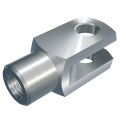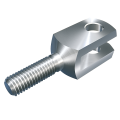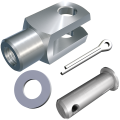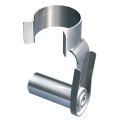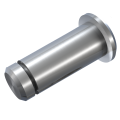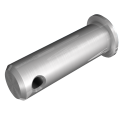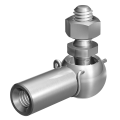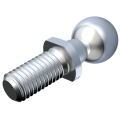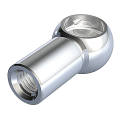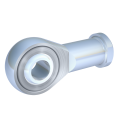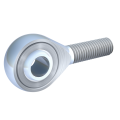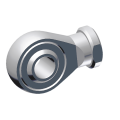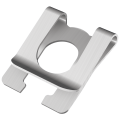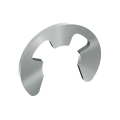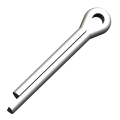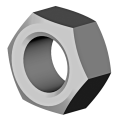1. Product description
Nuts for T-slots DIN 508, also known as T-slot nuts, are specialized fastening elements designed for use in T-slot constructions according to DIN 650. Made from hardened steel, they provide high strength and durability. These nuts feature a standardized, square design with a threaded hole available in various sizes to accommodate different screw diameters. The bottom of the nut is shaped to fit precisely into the T-slots of machine tables, clamping plates, T-slot rails, or other fixtures. This fit allows for a strong and stable anchoring for fastening and clamping operations. The core function of DIN 508 T-slot nuts is their ability to be used in combination with compatible clamping elements such as screws or bolts to securely and efficiently attach workpieces, components, or fixtures to machine tables or work plates. This fastening method ensures precise alignment and high repeatability in production and assembly processes, making them ideal for use in precise manufacturing environments.
2. Product details
Size: M4 x 5 – M48 x 54
Material group: Steel
Surface: bright, electr. galvanized white
Thread version: Regular thread right
3. Application Areas & Compatibility
Nuts for T-slots according to DIN 508 are used in a wide range of industrial and craft sectors, where precision is the focus.
These include, among others:
Mechanical engineering and metal processing: Here they are mainly used for securing workpieces on machine tables of milling, drilling, or grinding machines. The high strength and precision enable efficient and precise work, even under high loads.
Toolmaking and mold making: In these sectors, precise and reproducible clamping processes are essential. Nuts for T-slots DIN 508 offer the necessary reliability and reusability to correctly and safely position tools and molds.
Assembly and testing facilities: They provide a flexible yet stable base for assembling small parts to testing large assemblies, where repeatable accuracy is required.
Home workshops: For hobbyists who enjoy working with metal or wood, T-slot nuts are an ideal solution for securing workpieces on workbenches or DIY CNC machines. They enable flexible and stable clamping for precise milling, drilling, or grinding work.
Model making: In model making, especially when building larger models or working on precision parts, these nuts can be helpful for assembly purposes or as part of the construction itself. Their strength and reusability make them a good choice for permanent or repeatable attachments.
The compatibility of DIN 508 T-slot nuts encompasses several dimensions:
T-slot sizes: Their shape and size are dimensioned for use with standardized T-slots, meaning they can be easily inserted into all corresponding slots. It is important to choose the correct size of the T-slot nut according to the T-slot in the tool table or fixture to ensure optimal fit and performance.
Clamping elements: The nuts are compatible with a variety of clamping elements such as screws, set screws, and threaded bolts. This allows them to be used in a wide range of fastening and clamping applications. The internal thread size of the nut must match the thread of the clamping element used.
Materials: Although the nuts themselves are mainly made of steel, the universal and flexible design as well as the standard compliance of DIN 508 T-slot nuts allow their broad application across various industries, making them an indispensable element in modern manufacturing and assembly.
4. Advantages and Benefits
Nuts for T-slots according to DIN 508 offer a range of advantages and benefits in both industrial and private application areas. These include:
Precision fit: Due to their standardized shape and size, they fit exactly into the intended T-slots, ensuring high precision in the positioning of workpieces or fixtures.
Consistent quality: The DIN 508 standard guarantees consistent quality and reliability, meaning users can expect predictable performance.
Wide range of applications: They can be used in many different areas, such as mechanical engineering, assembly, tool and mold making, as well as for hobby projects.
Compatibility: Their standardized size and internal thread offer broad compatibility with various clamping elements such as screws or bolts, increasing their applicability in different contexts.
Durability: Made from high-strength steel, these nuts are extremely robust and wear-resistant, ensuring a long service life even under high loads or in demanding environments.
Cost efficiency: Due to their longevity and the possibility of multiple reuse, they offer excellent value for money. Investing in high-quality T-slots can mean long-term savings through fewer failures and less need for replacements.
Secure fastening: T-slots ensure a firm and secure connection between the workpiece and machine table or fixture, reducing the risk of slipping or accidents.
High load capacity: They can absorb high forces, making them ideal for applications where safety and reliability under load are critical.
Easy installation: Their specific shape allows for easy and quick insertion into T-slots, simplifying and speeding up the assembly and disassembly process.
Reusability: T-slots are effortlessly reusable, making them a sustainable and cost-saving solution, especially in environments where regular configuration changes are required.
In summary, nuts for T-slots according to DIN 508 offer an efficient, reliable, and durable solution for a variety of clamping and fastening requirements in both professional and hobby applications.
5. Assembly and Installation
Step 1 – Preparation:
- Check the surface: Ensure the T-slots are clean, free of dirt, chips, or corrosion. A clean surface improves fit and performance.
- Inspect the nuts: Check the nuts for any damage or deformation. Damaged nuts should not be used.
Step 2 – Positioning:
- Align the nuts: Position the nuts so that the thread is perpendicular to the T-slot orientation and the slot of the nut faces upward.
- Inserting: Slightly tilt the nut and slide it into the T-slot from the side. Once the nuts are threaded, you can slide them along the T-slot to the desired position.
Step 3 – Fastening:
Choose an appropriate threaded bolt or screw that fits through the internal thread of the nut. Make sure the length of the component is adequate to ensure secure fastening without damaging the workpiece or the machine table.
Installation: Screw the chosen component into the internal thread of the T-slot nut. Tighten the connection so that the workpiece is securely and firmly fixed to the machine table or fixture. Use the recommended torque to avoid overstrain or damage.
Step 4 – Inspection:
- Check safety: After tightening, check all connections for strength and stability. The nut should sit firmly in the T-slot, and there should be no movement between the workpiece and the base.
- Make corrections: If necessary, adjust the position of the nut or tighten the connection further to ensure optimal alignment and security.
Tips for successful assembly:
- Use tools: For more efficient installation, special wrenches or allen keys can be used to reach the recommended torque more easily.
6. Accessories and Extensions
For nuts for T-slots according to DIN 508, there are various extensions and accessories that enhance the applicability and flexibility of these fasteners. Some of these accessories are specifically designed to simplify installation, increase functionality, or improve adaptability to special requirements. Here are some examples:
Extension and linking elements:
Threaded bolts or rods can be used to extend the reach of T-slot nuts or to fasten multiple objects at different heights. Connection nuts serve to connect two or more screws or threaded rods together to increase the overall length.
Clamping levers and tension screws:
Clamp lever or tension screw sets offer a quick and tool-free way to tighten or loosen nuts for T-slots, which is particularly useful in applications where frequent adjustments are necessary.
Special T-slot nuts according to drawing:
Special nuts for T-slots with specific characteristics such as non-standard dimensions, higher tensile strength, corrosion resistance, or thermal resistance are recommended for demanding applications. These special T-slot nuts are individually designed for the application and manufactured as custom parts. Please contact us directly via contact form if needed.
Positioning elements:
Studs and threaded bolts serve as precise positioning or stop points in conjunction with T-slot nuts. These accessories help to improve efficiency, safety, and precision in assembly and fastening tasks. The selection of the right accessories depends on the specific requirements of the respective application.

